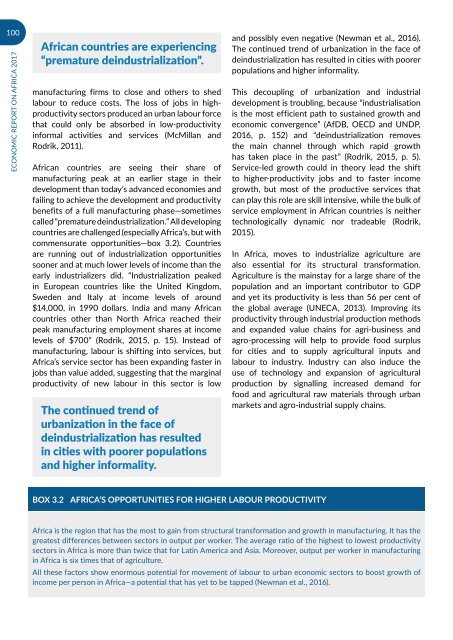URBANIZATION AND INDUSTRIALIZATION
Economic%20Report%20on%20Africa%202017%20UNECA
Economic%20Report%20on%20Africa%202017%20UNECA
You also want an ePaper? Increase the reach of your titles
YUMPU automatically turns print PDFs into web optimized ePapers that Google loves.
100<br />
ECONOMIC REPORT ON AFRICA 2017<br />
African countries are experiencing<br />
“premature deindustrialization”.<br />
manufacturing firms to close and others to shed<br />
labour to reduce costs. The loss of jobs in highproductivity<br />
sectors produced an urban labour force<br />
that could only be absorbed in low-productivity<br />
informal activities and services (McMillan and<br />
Rodrik, 2011).<br />
African countries are seeing their share of<br />
manufacturing peak at an earlier stage in their<br />
development than today’s advanced economies and<br />
failing to achieve the development and productivity<br />
benefits of a full manufacturing phase—sometimes<br />
called “premature deindustrialization.” All developing<br />
countries are challenged (especially Africa’s, but with<br />
commensurate opportunities—box 3.2). Countries<br />
are running out of industrialization opportunities<br />
sooner and at much lower levels of income than the<br />
early industrializers did. “Industrialization peaked<br />
in European countries like the United Kingdom,<br />
Sweden and Italy at income levels of around<br />
$14,000, in 1990 dollars. India and many African<br />
countries other than North Africa reached their<br />
peak manufacturing employment shares at income<br />
levels of $700” (Rodrik, 2015, p. 15). Instead of<br />
manufacturing, labour is shifting into services, but<br />
Africa’s service sector has been expanding faster in<br />
jobs than value added, suggesting that the marginal<br />
productivity of new labour in this sector is low<br />
The continued trend of<br />
urbanization in the face of<br />
deindustrialization has resulted<br />
in cities with poorer populations<br />
and higher informality.<br />
and possibly even negative (Newman et al., 2016).<br />
The continued trend of urbanization in the face of<br />
deindustrialization has resulted in cities with poorer<br />
populations and higher informality.<br />
This decoupling of urbanization and industrial<br />
development is troubling, because “industrialisation<br />
is the most efficient path to sustained growth and<br />
economic convergence” (AfDB, OECD and UNDP,<br />
2016, p. 152) and “deindustrialization removes<br />
the main channel through which rapid growth<br />
has taken place in the past” (Rodrik, 2015, p. 5).<br />
Service-led growth could in theory lead the shift<br />
to higher-productivity jobs and to faster income<br />
growth, but most of the productive services that<br />
can play this role are skill intensive, while the bulk of<br />
service employment in African countries is neither<br />
technologically dynamic nor tradeable (Rodrik,<br />
2015).<br />
In Africa, moves to industrialize agriculture are<br />
also essential for its structural transformation.<br />
Agriculture is the mainstay for a large share of the<br />
population and an important contributor to GDP<br />
and yet its productivity is less than 56 per cent of<br />
the global average (UNECA, 2013). Improving its<br />
productivity through industrial production methods<br />
and expanded value chains for agri-business and<br />
agro-processing will help to provide food surplus<br />
for cities and to supply agricultural inputs and<br />
labour to industry. Industry can also induce the<br />
use of technology and expansion of agricultural<br />
production by signalling increased demand for<br />
food and agricultural raw materials through urban<br />
markets and agro-industrial supply chains.<br />
Box 3.2 AFRICA’S OPPORTUNITIES FOR HIGHER LABOUR PRODUCTIVITY<br />
Africa is the region that has the most to gain from structural transformation and growth in manufacturing. It has the<br />
greatest differences between sectors in output per worker. The average ratio of the highest to lowest productivity<br />
sectors in Africa is more than twice that for Latin America and Asia. Moreover, output per worker in manufacturing<br />
in Africa is six times that of agriculture.<br />
All these factors show enormous potential for movement of labour to urban economic sectors to boost growth of<br />
income per person in Africa—a potential that has yet to be tapped (Newman et al., 2016).


